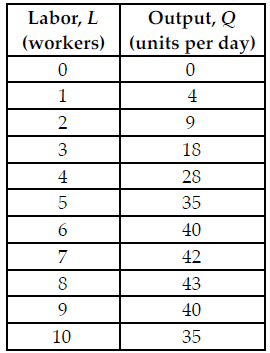When and how was Australia settled?
A. An interglacial period around 70,000 B.P. allowed the seafaring people of Tasmania to navigate to the Australian mainland.
B. Humans crossed the narrow straits separating Asia and the then-continent of Sahul (Australia, New Guinea, and Tasmania), perhaps in primitive watercraft, around 50,000 B.P.
C. Fossil evidence from Lake Mungo in New South Wales suggests that Australia was settled around 50,000 B.P. by humans following big game from Asia.
D. Fossil evidence from Lake Mungo in New South Wales suggests that Australia was settled as early as 100,000 years ago by Melanesian settlers who crossed the exposed land bridges connecting the Pacific islands.
E. A glacial period around 50,000 B.P. exposed a land bridge connecting Asia and Australia, making it possible for humans to cross over on foot.
Answer: B
You might also like to view...
Refer to the table below. When the ________ worker is hired, the firm experiences decreasing marginal returns of labor.

A) 4th B) 6th C) 2nd D) 3rd
Among the Old World monkeys, the subfamily Colobinae is characterized by a:
A. sacculated stomach B. cheek pouch C. prehensile tail D. all of these
Globalization is an ongoing and never-ending process
a. True b. False Indicate whether the statement is true or false
By building a plant in Plachimada, India, the Coca-Cola Company fundamentally changed the lives of people there. To fully understand how Plachimada women responded and were affected, a cultural anthropologist would MOST likely need to include which of the following in their research plan?
a meeting with national survey geographers to learn about water table levels across India a survey of intergenerational speech to learn about the languages spoken by women interviews with Coca-Cola personnel to learn about their negotiations with the women participant observation with construction workers at the plant to learn how it was built